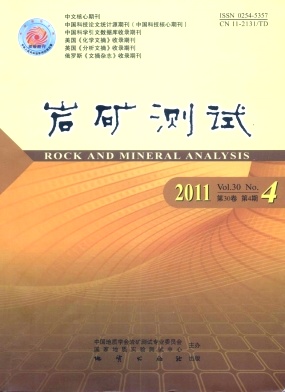ZHAO Su-li, ZHANG Xin, LI Man, WEN Hong-li, QU Wen-jun, CAO Ya-ping, LI Chao. Determination of Platinum Group Elements in Pyrite Samples by Inductively Coupled Plasma-Mass Spectrometry with Nickel Sulphide Fire Assay[J]. Rock and Mineral Analysis, 2011, 30(4): 412-415.
| Citation: |
ZHAO Su-li, ZHANG Xin, LI Man, WEN Hong-li, QU Wen-jun, CAO Ya-ping, LI Chao. Determination of Platinum Group Elements in Pyrite Samples by Inductively Coupled Plasma-Mass Spectrometry with Nickel Sulphide Fire Assay[J]. Rock and Mineral Analysis, 2011, 30(4): 412-415.
|
Determination of Platinum Group Elements in Pyrite Samples by Inductively Coupled Plasma-Mass Spectrometry with Nickel Sulphide Fire Assay
-
1.
National Research Center for Geoanalysis, Beijing 100037, China
-
2.
National Research Center for Geoanalysis, Beijing 100037, China
-
3.
National Research Center for Geoanalysis, Beijing 100037, China
-
4.
National Research Center for Geoanalysis, Beijing 100037, China
-
5.
National Research Center for Geoanalysis, Beijing 100037, China
-
6.
National Research Center for Geoanalysis, Beijing 100037, China
-
7.
National Research Center for Geoanalysis, Beijing 100037, China
-
Abstract
Nickel sulphide fire assay is the common method to determine platinum group elements (PGEs) for most geological samples by inductively coupled plasma-mass spectrometry (ICP-MS). However, there are few reports on pyrite samples. According to the characteristics of pyrite, which is abundant in S and Fe, routine fusion flux cannot produce an ideal nickel sulphide button, which makes the next chemical steps difficult ie dissolution and filtration. In this paper, the chemical procedure of nickel sulphide fire assay has been improved to measure the PGEs contents for pyrite by ICP-MS. The fusion flux and molten slag was changed in order to yield the ideal button without losing any of the sampling weight. The improved method gives the button the optimum capability to extract PGEs from the fusant and avoid PGEs loss from prolonged heating and reaction. As the button is easy to peel and effloresce, the procedure of button crushing is unnecessary, which not only simplifies the process, but also avoids the possibility of cross contamination. The results indicate that high content of Fe do not significantly affect the measurement of PGEs content. The whole recovery procedure was more than 94% and the detection limits of 10 g samples for Ru, Rh, Pd, Os, Ir and Pt were 0.018 ng/g, 0.017 ng/g, 0.18 ng/g, 0.019 ng/g, 0.013 ng/g and 0.11 ng/g, respectively. The results of different pyrite samples and standard material indicate that this method is an improvement on previous methods by meeting the requirements for PGEs determination of most pyrite.
-

-
-
Access History







 DownLoad:
DownLoad: